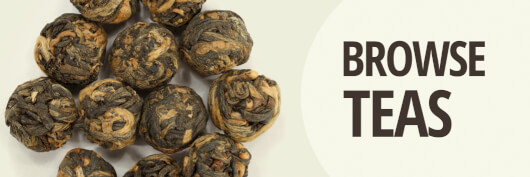Pairing Tea With Food
Exploring the world of connoisseur-level teas is as intoxicating as that other
beverage: Wine. For wine lovers, the current fashion is not to insist that
whites pair up with poultry nor drink only reds with meat. This has led to many
adventuresome pairings and new taste sensations.
Fortunately, teas pairings are also open to exploration. Anyone who says blacks are only for entrees or that greens must stand alone, haven't had the pleasure (or perhaps the opportunity) to pair a wide variety of teas with every part of a menu.
What follows are some of my favorite pairings; however, if there is one rule I adhere to, it is to follow Confucius's maxim, "Let your palate be your guide."
For both elegance and whimsy, nothing sets the mood for a memorable dinner than a tall white-wine glass with a showplace 'mudan' dancing its way into blossoming.
Mudans are tea leaves tied together with other tea leaves or silk thread in a myriad of shapes. With an almost magical ability, they infuse into fuller, more beautiful versions of anemones, peonies, chrysanthemums, strawberries, hummingbird's 'nests', and other shapes for which they are named. Their nearly magical ability to infuse over a long period of time, 20 to 30 minutes, without bitterness, means you can set them out when you serve the appetizer, and they will slowly release their delicate liquor until ready to drink with either the encore or dessert. Mudans can be either black or green Chinese tea.
DIRECTIONS: Place one mudan at the bottom of a white wine glass, pour on underboiling water, about 185 degrees F., and allow to infuse. Good-quality mudans will stay on the bottom of the glass, and you can drink the liquor without removing it. If you prefer to remove the mudan, use a spoon to remove it and place it on a small soy dish or a ceramic teabag holder.
If mudans are hard to find, consider Silver Needle, a light white tea that is ideal for tall glass tumblers which enable the leaves to do their ballet movement up and down the glass; another charming way to introduce guests to unique tea drinking. Underboiling water is also used, but the infusion time need only be 1 1/2 to 3 minutes depending on the quality of the tea.
The ceremony of warming up a small gung fu pot on a drainer, brewing the tea gently, and pouring it into small thimble-sized cups is a rather Zen-like experience that seems to match the ethereal taste of Pi Lo Chun, perhaps, or the more traditional gung fu choice, oolong. It is a gentle way to drink tea, an inviting way for guests to socialize, a way that you as the host can create an aura of calm before an exquisite meal.
Mudans are also wonderful for an aperitif. Begin the brewing process about fifteen minutes before guests are expected to arrive. Serve them in either white-wine glasses or tall champagne glasses. While passing them around on an elegant silver tray, you can tell your guests what to expect. This is a wonderful conversation starter for a group that does not know each other and, of course, it's just plain fun!
Crushed blacks mixed with spices make a good marinade for fish or poultry, creating a crust that's healthful and full of flavor.
Brewed, tea makes a marvelous tenderizing marinade, poaching liquid, or broth for grains or rice.
The possibilities are endless, and delicious. Best of all, tea adds no calories, sodium, sugar or fat to your meals, just tons of flavor.
Should you cook or bake a dish with tea, the easiest choice is to pair it with the same tea brewed for drinking. This will not only enhance the tea used in the dish, but also offer your guests the added benefit of a pure tea tasting experience.
Greens like Dragonwell or Ceylon greens are wonderful with seafood or fish fillets, salads, or chicken. Blacks like Keemun (Qiman) or smooth Indonesian blacks are soft accompaniments to beef or steak dishes or spicy foods from Mexican, Italian, or Indian cuisine. Although it is traditional to have oolongs with Chinese dishes, I've found that rich black Yunnans or Keemuns offer more complexity and layers to the experience of tea pairings.
Taiwanese oolongs and pouchongs seem to demand solo drinking, quiet, and something restful to look upon. However, oolongs are delicious in many foods. Try them to flavor liquids used for cooking rice or grains. They add a wonderful punch, and like all tea, no calories, sodium, or sugar!
For desserts, seek out the chocolaty essence of black Fujian, China teas. Hearty and rich, they tastes perfect when infused into baked custards, chocolate cakes, or drunk as a beverage with a rich dense strawberry shortcake. Assam is another rich black tea that complements chocolate desserts yet is a surprising foil against lemony or custard dishes.
As a digestive, nothing is better, more satisfying or more calming than an aged Chinese pu-erh, the darker, the stronger, the better. The only intentionally aged tea, it is particularly good after a multiple-course feast like a Thanksgiving or similar heavy holiday meal. If you're a milk-and-cookies snacker before bedtime, try pu-erh instead. You'll sleep well, and will wake up feeling great.
Fortunately, teas pairings are also open to exploration. Anyone who says blacks are only for entrees or that greens must stand alone, haven't had the pleasure (or perhaps the opportunity) to pair a wide variety of teas with every part of a menu.
What follows are some of my favorite pairings; however, if there is one rule I adhere to, it is to follow Confucius's maxim, "Let your palate be your guide."
The Mudan
Showplace Teas That Entertain and EnchantFor both elegance and whimsy, nothing sets the mood for a memorable dinner than a tall white-wine glass with a showplace 'mudan' dancing its way into blossoming.
Mudans are tea leaves tied together with other tea leaves or silk thread in a myriad of shapes. With an almost magical ability, they infuse into fuller, more beautiful versions of anemones, peonies, chrysanthemums, strawberries, hummingbird's 'nests', and other shapes for which they are named. Their nearly magical ability to infuse over a long period of time, 20 to 30 minutes, without bitterness, means you can set them out when you serve the appetizer, and they will slowly release their delicate liquor until ready to drink with either the encore or dessert. Mudans can be either black or green Chinese tea.
DIRECTIONS: Place one mudan at the bottom of a white wine glass, pour on underboiling water, about 185 degrees F., and allow to infuse. Good-quality mudans will stay on the bottom of the glass, and you can drink the liquor without removing it. If you prefer to remove the mudan, use a spoon to remove it and place it on a small soy dish or a ceramic teabag holder.
If mudans are hard to find, consider Silver Needle, a light white tea that is ideal for tall glass tumblers which enable the leaves to do their ballet movement up and down the glass; another charming way to introduce guests to unique tea drinking. Underboiling water is also used, but the infusion time need only be 1 1/2 to 3 minutes depending on the quality of the tea.
Teas as Aperitifs
Ironically, light teas like spring greens or whites, for all their delicacy, can
stand up to hearty foods or serve as an aperitif to whet the appetite for more.
I like to serve them for intimate gatherings of two to six people when we can
sit around a low table in the living room, and enjoy them brewed gung fu style.The ceremony of warming up a small gung fu pot on a drainer, brewing the tea gently, and pouring it into small thimble-sized cups is a rather Zen-like experience that seems to match the ethereal taste of Pi Lo Chun, perhaps, or the more traditional gung fu choice, oolong. It is a gentle way to drink tea, an inviting way for guests to socialize, a way that you as the host can create an aura of calm before an exquisite meal.
Mudans are also wonderful for an aperitif. Begin the brewing process about fifteen minutes before guests are expected to arrive. Serve them in either white-wine glasses or tall champagne glasses. While passing them around on an elegant silver tray, you can tell your guests what to expect. This is a wonderful conversation starter for a group that does not know each other and, of course, it's just plain fun!
Cooking With Tea
The most exciting application for tea is using it in cooking. Dried leaves make
pretty, and delicious, garnishes. Try some crushed Gyokuro atop an omelet or
sprinkle some dried Dragonwell to add a little kick to salads.Crushed blacks mixed with spices make a good marinade for fish or poultry, creating a crust that's healthful and full of flavor.
Brewed, tea makes a marvelous tenderizing marinade, poaching liquid, or broth for grains or rice.
The possibilities are endless, and delicious. Best of all, tea adds no calories, sodium, sugar or fat to your meals, just tons of flavor.
Should you cook or bake a dish with tea, the easiest choice is to pair it with the same tea brewed for drinking. This will not only enhance the tea used in the dish, but also offer your guests the added benefit of a pure tea tasting experience.
The Art of Pairing Teas
The art of pairing teas with each course is still being developed, and part of
the education (and delight) of discovering what teas your palate enjoys with
which foods.Greens like Dragonwell or Ceylon greens are wonderful with seafood or fish fillets, salads, or chicken. Blacks like Keemun (Qiman) or smooth Indonesian blacks are soft accompaniments to beef or steak dishes or spicy foods from Mexican, Italian, or Indian cuisine. Although it is traditional to have oolongs with Chinese dishes, I've found that rich black Yunnans or Keemuns offer more complexity and layers to the experience of tea pairings.
Taiwanese oolongs and pouchongs seem to demand solo drinking, quiet, and something restful to look upon. However, oolongs are delicious in many foods. Try them to flavor liquids used for cooking rice or grains. They add a wonderful punch, and like all tea, no calories, sodium, or sugar!
For desserts, seek out the chocolaty essence of black Fujian, China teas. Hearty and rich, they tastes perfect when infused into baked custards, chocolate cakes, or drunk as a beverage with a rich dense strawberry shortcake. Assam is another rich black tea that complements chocolate desserts yet is a surprising foil against lemony or custard dishes.
As a digestive, nothing is better, more satisfying or more calming than an aged Chinese pu-erh, the darker, the stronger, the better. The only intentionally aged tea, it is particularly good after a multiple-course feast like a Thanksgiving or similar heavy holiday meal. If you're a milk-and-cookies snacker before bedtime, try pu-erh instead. You'll sleep well, and will wake up feeling great.


